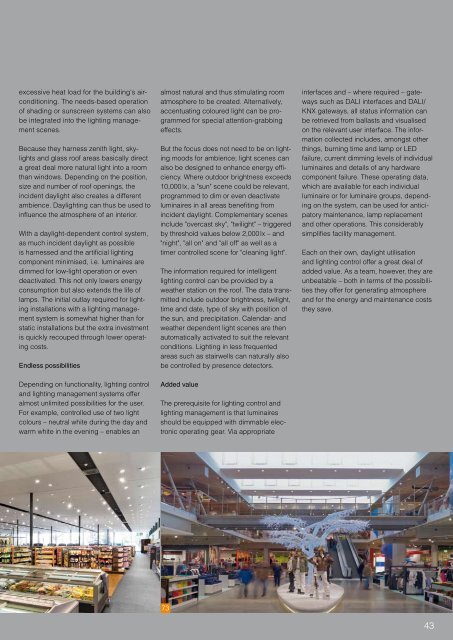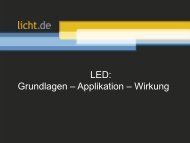licht.wissen No. 06 "Shop Lighting - Attractive and Efficient"
licht.wissen 06 provides a practical and user-oriented summary of attractive and efficient shop lighting. More information about professional lighting: www.licht.de/en
licht.wissen 06 provides a practical and user-oriented summary of attractive and efficient shop lighting. More information about professional lighting: www.licht.de/en
You also want an ePaper? Increase the reach of your titles
YUMPU automatically turns print PDFs into web optimized ePapers that Google loves.
excessive heat load for the building's airconditioning.<br />
The needs-based operation<br />
of shading or sunscreen systems can also<br />
be integrated into the lighting management<br />
scenes.<br />
Because they harness zenith light, skylights<br />
<strong>and</strong> glass roof areas basically direct<br />
a great deal more natural light into a room<br />
than windows. Depending on the position,<br />
size <strong>and</strong> number of roof openings, the<br />
incident daylight also creates a different<br />
ambience. Daylighting can thus be used to<br />
influence the atmosphere of an interior.<br />
With a daylight-dependent control system,<br />
as much incident daylight as possible<br />
is harnessed <strong>and</strong> the artificial lighting<br />
component minimised, i.e. luminaires are<br />
dimmed for low-light operation or even<br />
deactivated. This not only lowers energy<br />
consumption but also extends the life of<br />
lamps. The initial outlay required for lighting<br />
installations with a lighting management<br />
system is somewhat higher than for<br />
static installations but the extra investment<br />
is quickly recouped through lower operating<br />
costs.<br />
Endless possibilities<br />
Depending on functionality, lighting control<br />
<strong>and</strong> lighting management systems offer<br />
almost unlimited possibilities for the user.<br />
For example, controlled use of two light<br />
colours – neutral white during the day <strong>and</strong><br />
warm white in the evening – enables an<br />
almost natural <strong>and</strong> thus stimulating room<br />
atmosphere to be created. Alternatively,<br />
accentuating coloured light can be programmed<br />
for special attention-grabbing<br />
effects.<br />
But the focus does not need to be on lighting<br />
moods for ambience; light scenes can<br />
also be designed to enhance energy efficiency.<br />
Where outdoor brightness exceeds<br />
10,000 lx, a "sun" scene could be relevant,<br />
programmed to dim or even deactivate<br />
luminaires in all areas benefiting from<br />
incident daylight. Complementary scenes<br />
include "overcast sky", "twilight" – triggered<br />
by threshold values below 2,000 lx – <strong>and</strong><br />
"night", "all on" <strong>and</strong> "all off" as well as a<br />
timer controlled scene for "cleaning light".<br />
The information required for intelligent<br />
lighting control can be provided by a<br />
weather station on the roof. The data transmitted<br />
include outdoor brightness, twilight,<br />
time <strong>and</strong> date, type of sky with position of<br />
the sun, <strong>and</strong> precipitation. Calendar- <strong>and</strong><br />
weather dependent light scenes are then<br />
automatically activated to suit the relevant<br />
conditions. <strong>Lighting</strong> in less frequented<br />
areas such as stairwells can naturally also<br />
be controlled by presence detectors.<br />
Added value<br />
The prerequisite for lighting control <strong>and</strong><br />
lighting management is that luminaires<br />
should be equipped with dimmable electronic<br />
operating gear. Via appropriate<br />
interfaces <strong>and</strong> – where required – gateways<br />
such as DALI interfaces <strong>and</strong> DALI/<br />
KNX gateways, all status information can<br />
be retrieved from ballasts <strong>and</strong> visualised<br />
on the relevant user interface. The information<br />
collected includes, amongst other<br />
things, burning time <strong>and</strong> lamp or LED<br />
failure, current dimming levels of individual<br />
luminaires <strong>and</strong> details of any hardware<br />
component failure. These operating data,<br />
which are available for each individual<br />
luminaire or for luminaire groups, depending<br />
on the system, can be used for anticipatory<br />
maintenance, lamp replacement<br />
<strong>and</strong> other operations. This considerably<br />
simplifies facility management.<br />
Each on their own, daylight utilisation<br />
<strong>and</strong> lighting control offer a great deal of<br />
added value. As a team, however, they are<br />
unbeatable – both in terms of the possibilities<br />
they offer for generating atmosphere<br />
<strong>and</strong> for the energy <strong>and</strong> maintenance costs<br />
they save.<br />
73<br />
43

















